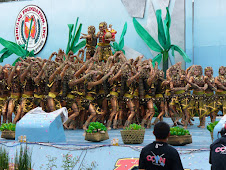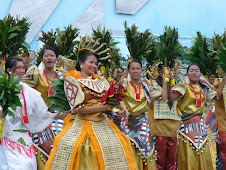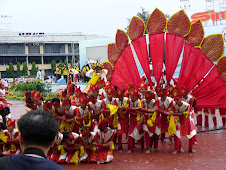Friday, September 25, 2015
Saturday, May 9, 2015
Monday, February 10, 2014
Friday, February 12, 2010
LAISSEZ LES BONS TEMPS ROULER!: Reflections of a First-Time Visitor to New Orleans
 Bourbon Street coming to life at dusk
Bourbon Street coming to life at dusk

The Mardi Gras parades starting one week early

The St. Louis Cathedral at Jackson Square
The “Good Times” and “New Orleans” are two concepts that seem to dovetail neatly with each other. This much, I saw first hand, in my first trip to “the Big Easy” early this month, less than 5 years after a double tragedy put the proud and fun-loving city to its knees. Hurricane Katrina, followed a month after by hurricane Rita exposed the soft under belly of America. More than 1,500 people perished, and thousands and thousands more lost all they had.
I really had no reason to be anywhere near the city where French, Spanish, English, Italian, Cuban, German, and American cultures are all rolled into one. The famous “French Quarter” was not always French all the way, for starters. The Calle Real, what is now known as Royal street, still bears the Spanish street sign. But Bourbon Street, though, spelled in French, really had to do with the Spanish Borbon dynasty of yore.
But I think that nowhere else is this happy mélange of cultures seen as in the food that the locals seem to be very proud of … fusion cuisine invented even before the term came to be known the world over! A seafood mecca, the city loves oysters, on the half shell, grilled or fried in a motley manner to become succulent gustatory delights. It was my first time to see and taste “po-boy” sandwiches filled with shrimps or other seafood, battered and deep fried, always with a touch of hot chili and spices that literally give a bite to whatever one bites into and sinks one’s teeth into. The “gumbo” – steaming hot and often spicy hot stew seemed to me the perfect accompaniment to oil-spattered deep fried sandwich fillings that would make the heart skip a beat in these TFA (trans-fatty acids) scare days and times.
But I was there for a few days … an unplanned trip that coincided with a conference on leadership organized by the National Catholic Educational Association. Since this has to do with precisely what I am trying to steer the school I work in to, I had to decide quickly early last month to go.
And I must say I have no regrets about spending a few days there. The first day, though, was a dampener. It was raining cats and dogs – the very same rain brought about by a developing storm that became the headache and the problem upper north, in the mid-Atlantic states, that dumped inches and inches of snow from Washington, DC, Virginia, to Maryland, to Pennsylvania, to New York.
Groggy and disoriented from a more than 24 hour trip from the tropics, I came to New Orlean’s sub-tropical climate that boasted of rains that I am most familiar with. The temperature ranged from a comfortable low to high 50s, but the downpour brought flooding that wet my feet as we wended our way to Mass with the Archbishop Gregory Aymond, a New Orleans native, recently transferred from Austin, Texas (in the same Cathedral where just two years ago, I attended and took part in a wedding Mass of a nephew).
I came at a time when feverish preparations are under way for the Mardi Gras celebrations, another well-known event associated with the “Big Easy.” Actually, I was told that it really started right after the Feast of the Epiphany. Although, I won’t be there next week when Fat Tuesday (Mardi Gras) actually takes place with all the pomposity and pageantry that only New Orleans can pull off, with the possible exception of Rio de Janeiro’s own Mardi Gras, I saw a preview of what was to come … small parades replete with costumes galore and goblets that overflowed with champagne and wine, carried by medieval attired characters that all had one message in common … Laissez les bon temps rouler! Let the good times roll!
I am happy for New Orleans. As I watched with all the rest of America the Super Bowl games at Miami, Florida, with the New Orleans Saints slugging it out with the Indianapolis Colts, there was no doubt in my heart that I rooted for the underdogs – the Saints. But I knew deep in my heart, too, that I did not root for them because I did not like the Colts. I found out later that for a Filipino deeply rooted in Spanish influenced Catholic culture, there was simply a whole slew of reasons why I felt like rooting for the Saints.
They are a resilient people, to start with … like us Pinoys, who have seen more than our fair share of Katrinas and Ritas back home. We had a double whammy late last year – Ondoy and Pepeng – that literally inundated our best dreams and our mighty hopes to take our rightful place under the Asian sun of national respectability and honor.
New Orleans suffered a big blow from Katrina and Rita. Much of the city remains to be rehabilitated. Much of what they lost remains to be restored. But in the conference, I heard stories of magnanimity and far-ranging vision … like the story of Holy Cross School that was literally wiped out by the floods. They had to relocate, without sure resources forthcoming, without certain funds and unalloyed support from everyone. It was almost, then, a hopeless dream, an impossible undertaking. Today, less than five years after, the 95 million project that is the renewed Holy Cross School, is well on the way towards forging new heights, literally and figuratively. They have risen, not from the ashes like the Phoenix, but risen above the doldrums of hopelessness, indifference, and inertia.
As I listened to the stories of those who made it happen, my thoughts got back to home base, back in tropical Philippines, where dreams and hopes lie battered and bruised by a dysfunctional political system that breeds storms and stresses far worse than Katrina, Rita, Ondoy, and Pepeng – the curse of a corruption-ridden, patronage, and personage-based politics that is the bane and shame of a once-proud people, cultured in the fineries of religion and spirituality, who also know how to celebrate, with Sinulogs, Dinagyangs, Masskara, and all …
Who dat? Who dat say dey will beat dem saints? This was the mantra and chant that the whole city (and perhaps the whole state) would sing, shout, and proclaim in the run-up to the Super Bowl. Their dream since Katrina and Rita brought them to their knees paid off. It became a reality last Sunday in Miami, Florida. Their hopes fondled with care and a lot of hard work since 2006 were fulfilled. They won. And how!
Boy, was I glad to be part of the excitement! And was I glad to be part of the exhilaration after the victory! To savor it all, I tried the famous gumbo and the red beans and rice (spicy like most everything). I tasted the much-vaunted beignets at Café du Monde, over at Decatur St. – at the French market. The café au lait might not have been that good as claimed (for a self-styled coffee connoisseur that I claim myself to be!); the chicory flavor might actually have ruined the coffee for me who simply wants the taste of coffee plain and simple – and – unadulterated; the beignets might not have been nothing more than just donuts minus the hole, but they sure came with a generous dose of confectioner’s sugar, and served with a lot of panache and hometown pride. And that made all the difference!
Again, as I slowly savored the beignets and sipped my chicory flavored coffee, and as I watched the steady flow of crowds who all wanted to get generous helpings of beignets smothered with snowy and sugary delight, my thoughts raced back to home base faster than the white powder could raise my blood sugar levels, and I thought that what we needed, apart from believing in ourselves as a people for us to get out of the doldrums of underdevelopment, is to have simple, honest, and well-deserved sense of pride in what we have, what we can do, and what we are best at doing, as a people.
One of them happens to be similar to what people at the Big Easy seem to be experts at … partying for a good cause! They sure know how to party…. Yes! But they sure know too, how to work so as to deserve a party.
Laissez les bon temps rouler! Let the good times roll!
Friday, October 31, 2008
GOLD, NOT JUST GLITTER, IN THE CITY OF GOLDEN FRIENDSHIP

First timers in any city are always in for big surprises.
I have always wanted to be in Cagayan de Oro city ever since I learned – of all places, in Vancouver, BC, Canada, ten years ago that the Philippines, through GenSan and CDO was actually, then, the world’s top exporter of tuna.
My friends were then taking me for a stroll through the port area of Vancouver and we happened to pass by the fish market. As we were approaching one of the stalls, a tall, white and lanky Canadian man, suddenly called out to us in perfect and very polite Tagalog, “Ano ho ang hanap nila?” I was stunned. After the initial shock, I engaged the man in conversation and asked him how come he spoke so good Tagalog. “Matagal ako tumira sa Batangas at saka sa Mindoro,” was his answer. But that was not the best surprise. As we made known our desire to buy some “sock-eye salmon” for me to bring home to California, he quipped: “I bet you didn’t know that the Philippines is the number one exporter of tuna in the world!”
Indeed, I didn’t know … just as I didn’t know – up till now – that Boracay’s beaches are actually better, if not, on the same footing, as the best that Bali in Indonesia, and Pattaya in Thailand, could offer, at least if we are talking about their natural, pristine state. Once, when my siblings treated me to a cruise from Los Angeles to Encinada, Mexico, I bumped into a group of Caucasians who have been to Boracay. The conversation veered towards the topic on beaches. One of the men asked me point blank: “Have you been to Boracay?” “No, I haven’t unfortunately,” I answered. And then he asked me, “Then what are you doing here in Encinada?”
There was hardly anything worth anyone’s while in Encinada. It was pathetic, just as it was pathetic to see Caucasian tourists back in Monterey in California, to wax so enthusiastic and appear so surprised to ogle at nothing but the gently rolling surf where enterprising marketing experts have put up a sign that said: “The Restless Sea.” Dozens of them were having their picture taken alongside the sign. Coming as I do, from a country surrounded by sea everywhere, I could not understand how so many people could be so enamored by the sight of something so ordinary as the rolling surf glinting in the morning sun by the seashore.
I write as I await my flight back to Manila at Lumbia National Airport. The airport itself is nondescript, a little too small for a city that prides itself now as the gateway to Mindanao. But the location of the airport itself is welcome sight to travelers. Nestled on a plateau surrounded by undulating hillocks, covered with bright green and lush foliage all around, it clearly reminded me of how blessed the place and the people who live there are with relatively rich vegetation all around. I was told that the only setback to the airport sitting on hills was the fact that on foggy days, flights have to be diverted to Cebu a little further north. I thought the airport itself was just a little better and bigger than the one in Ozamis City, Misamis Occidental.
My five day stay in CDO was a welcome respite from the monotony of first semester classes, teaching, preaching, and celebrating Masses daily for others. A national seminar-workshop of counselors under the auspices of the Philippine Guidance Counseling Association, Inc. was what brought me there. When I came, it was surprising to note that the whole city was abuzz with visitors as several national events were being held there. All the hotels were booked solid and all the humble “motorelas” (what is known in the north as tricycles) appeared poised and ready for the influx of riders.
The first day saw almost 800 of us cramped in the biggest ballroom of Grand Caprice Hotel, attached to LKK (Lim Ket Kai Mall). The 2nd and 3rd days saw us, still cramped and uncomfortable, in various rooms of Capitol University, a privately owned university that appeared to be the closest competitor to the other Jesuit owned school, Xavier University.
The whole short stint that made me see nothing more than hotel, school, audio-visual rooms and listen to speakers, was, honestly, an enlightening experience. It was good to see a city with a lot of gold, albeit devoid of glitter usually associated with it. I saw it in the mostly courteous and honest taxi drivers I happened to associate with. Although not all were such, my experience with two of them, who were both locals, was enough to write off what appeared to me as less than honest dealing shown by one who happened to be from the Tagalog region up north.
I saw gold, too, in the relatively better preserved greenery in the city. I saw gold in the smart, courteous, and unassuming service provided by hotel staff and orderlies who dutifully made the rounds of the rooms. Whilst the room I had was not the best in terms of comfort as compared to what one finds in the US, for example, or even in other wealthier Asian neighbors, I could not have asked for more in what simple things they could offer. I saw gold too, as I strolled leisurely at the Divisoria area in what they call the “night café.” There was music. There was mirth. And there was gentle soothing massage over at the park from blind women and men, who were there, each night, providing a cheap way to instant relaxation and stress-relief with their agile hands and fingers.
They say travel makes for a good teacher. One learns a whole lot more in shorter a time, than one can learn poring through books and sitting through lectures. This trip to CDO was no exception, as was my trip a few months ago to Pagadian City, also in Northern Mindanao.
The world we live in is caught, for the most part, in a culture of having rather than being. If the mad rush for skin whitening lotions and concoctions is a sign of anything, I believe it has to do with that passionate search, for form, and not necessarily for substance., for appearances, and not for the essential invisible realities that matter the most in the long run.
We see manifestations of such everyday … from the bombastic grandstanding antics of the “trapos” (traditional politicians) whose tribes seem to increase by the day, to the mostly and primarily cosmetic changes that seem to characterize all the projects associated with that much hated pork barrel funds of the so-called honorable congressmen and senators.
The list is legion. Time and again, the police engage in token busts and token arrests to show they do their work. Occasionally, one hears of arrests being made, of shabu factories being raided, and small-time criminals facing the long arm of the law. But one wonders why no big fish are ever apprehended, and why only small fry land in jail at all. And if high profile and big fish criminals land in jail, why, they get pardons and reviews faster than you can utter “I am sorry for what I did.” One high profile criminal even went through the charade of presidential pardon, but who never ever even accepted he was guilty of anything! How on earth does one pardon anyone who professes innocence?
Whilst it is true that not all that glitters is gold. All that glitters nevertheless can pass off as gold for many people, at least for a while. In a world where appearances seem to count the most, ingesting drugs that produce temporary and erstwhile self-esteem via the right and desired color and skin tone, takes primacy over the big possibility of harmful, and permanently debilitating health issues associated with such drugs. In one media report after another, we have been apprised of individuals who succumb even to death on account of their overweening desire to acquire that much coveted body form, and skin color and complexion. Gold is mistaken for the superficial glitter.
I have seen a lot of glitter in my numerous trips all across the United States and Europe, especially in cities like Las Vegas, Reno, Atlantic City, and New York. But one does not have to go too far to see gold, sans the glitter, sans the glamor. I saw it in many varied, simple, and humble ways at Cagayan de Oro, the city of golden friendship. And how I wish the same were true all over this country, whose image has been so torn and tarnished by so much shallow politicking, a whole lot of divisive political posturings of “trapos” who, while claiming to do public service, only have the glitter and the glamour that come from it primarily in mind.
Sunday, August 17, 2008
KEEP AUSTIN WEIRD! (PILGRIM PATHWAYS, PART V)

A Trip Down the Fabled 6th Street
Austin is weird for many reasons. It seems to be a very educated city, given the presence of 60,000 university students. But it is weird also owing to the very same students making it possible for several blocks off 6th street coming to life at night, what with all its live musicians giving free rein to creativity and popular culture in all its bars and night clubs that sit right next to each other on 6th Street. It is weird on account of the fact that its capitol building towers 15 feet higher than the capitol building of Washington, DC. It is weird in the sense that it is very much an American city but where it wouldn’t be uncommon to hear individuals code shifting in the same breath between English to Spanish, with absolute ease. It is weird on account of the fact, that, whilst remaining to be a relatively livable city, it is home to a number of big commercial successes that America is replete with. Michael Dell started his own business enterprise that now is a household name all over the world. Austin, too, is home to Matthew McConnaughey, Sandra Bullock, and Kevin Costner, among others.
Wells and Domestics?
A quick look-see the first evening I was in Austin over at 6th Street gave me a feel for the local thrills of Austin by night. A brief stop at a local watering hole revealed a group of African Americans providing entertainment to patrons, seated, standing, or lolling about while nursing a bottle or a mug of either a beer that comes from a “well” – that is, tap beer, or what they call “domestics” or locally manufactured beer brands. They were singing the signature southern “blues” with that special rhythm that is at one and the same time, jazzy and emotionally fuzzy – at least to me.
Individuation and Self-Differentiation
“Keep Austin weird,” for me, is a lesson on individuation. It appears to me a telling lesson on the need for individuals – and communities and cities, for that matter – to define themselves, not in terms of comparing themselves with others, not in terms of what others are, or are not, but in terms of what they want to become.
The city, for me, offers a good illustration of what it means to have a solid self-identity in a world that seems to be dead bent on making everyone follow the bandwagon dictated by the forces of globalization, postmodernity, and the uniformity and mediocrity that both seem to engender, ultimately.
It stands at least for me, as a model of a city and people who would rather assert themselves in terms of their own vision, rather than defining themselves on the basis of how they are similar to, or different from, other cities.
Self-Differentiation at the Bottom of Many Issues
Back home, I see a different picture. The political circus that provides a never-ending telenovela-like story to a people already telenovela crazed, is almost something that would make anyone want to laugh or cry – or both at once – at the mere sight of the pathetic system that makes for the best reason why there is so much dysfunctionality – and massive poverty – in Philippine society. With politicians whose best vision rises no higher than the pathetic level of a politics of pillage and plunder, personage and patronage, with everyone trying to outdo one another, not exactly for altruistic motives, where individualism is understood as trying mutually to destroy each other, healthy self-differentiation goes out the window of political opportunism.
With a more than just lively opposition, waiting to pounce on the next opportunity to lunge for the throat of their political enemies, precious little energy is left to do what they love to mouth all the time – public service – never mind if most of that same public service is really self-serving on the long and short haul.
The same principle is pretty much at work everywhere – yes, including religious communities and church congregations. What we all love to call as “pastoral ministry” or “mission work” is oftentimes tainted with a whole lot of personal issues unacknowledged, unaccepted (that is, denied), and therefore, unprocessed. How else does one explain the all too common tendency to undo what the previous one did, or to simply ignore the achievements of the administration that one replaces? How else does one explain the build and destroy syndrome, that seems to be the hallmark of parishes and catholic schools everywhere in the country, where things that an earlier administration has put up are summarily destroyed by succeeding administrations?
Self-differentiation – or the patent lack of it – seems to be at the bottom of so many of our problems as a people and nation. Far too many of us are caught up in the burning desire to define who we are in terms of what others are, or are not, or in terms of what others have, or have not, achieved. It is self-definition at the cost of healthy individuation or healthy self-differentiation.
Classical Christian spirituality calls this pride – a certain inability to define, let alone accept, one’s own God given uniqueness and personal dignity. Where pride reigns, where lack of proper self-definition is the rule of the day, a lot of mutual self-destruction won’t be far behind.
Austin teaches me a lesson or two to bring home to the place I call home, by choice, by decision – for better or for worse. Keep Austin weird. Keep oneself healthily self-differentiated, without falling into the trap of either joining the bandwagon, or trying mightily and futilely, to use a phrase popularized by Kahlil Gibran, “to build a wall by trying to destroy a fence on the other side.”
Y’all take care now … and keep Austin weird!
Tuesday, July 1, 2008
PILGRIM PATHWAYS: PART IV
PIEN’ D’UMANITA IN FONDO ALL’ANIMA













